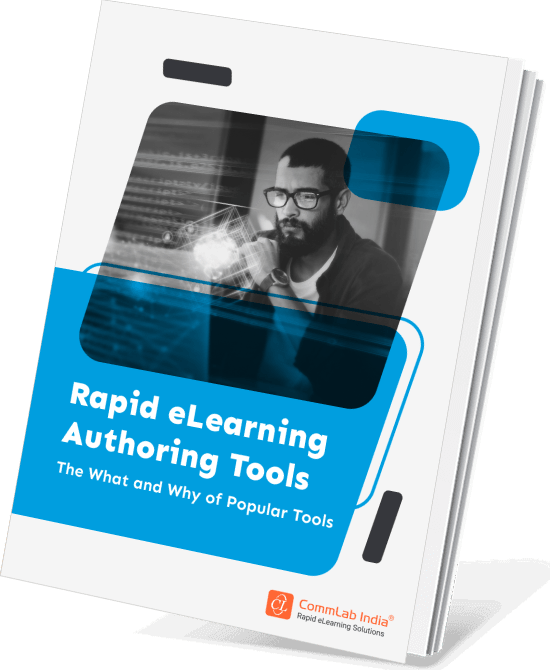SCORM Authoring Tools - 2024 Overview: Friend or Foe in Your eLearning Arsenal?

The landscape of corporate training is constantly evolving, and L&D professionals must adapt to stay ahead. SCORM authoring tools have been a cornerstone of eLearning development for years, providing a standardized framework for creating, packaging, and delivering online learning content. However, with the emergence of new technologies and changing learner expectations, it's time to reassess their suitability for modern eLearning initiatives.
In this blog post, we'll offer a critical analysis of SCORM authoring tools in 2024, exploring their strengths, weaknesses, and limitations. We'll discuss the benefits and drawbacks of using SCORM in today's eLearning landscape, considering factors such as interoperability, tracking and reporting capabilities, and LMS integration. Additionally, we'll examine emerging trends in authoring tools and explore alternative options that may be better suited for specific eLearning needs.
By the end of this blog post, L&D professionals will have a clearer understanding of SCORM authoring tools and be able to make informed decisions about their eLearning development strategies.
→ Download eBook: Rapid eLearning Authoring Tools: Explore What and Why
Table of Contents
- What are SCORM Authoring Tools, Anyway?
- What Are the Top Features of SCORM Authoring Tools?
- What Are the Limitations of SCORM Authoring Tools?
- What is the Role of the Instructional Designer (ID) in a SCORM Authoring Tool World?
- What Are the Best SCORM Authoring Tools of 2024?
What are SCORM Authoring Tools, Anyway?
Defining SCORM
SCORM, or Shareable Content Object Reference Model, is a standardized framework that revolutionized the corporate eLearning landscape. By providing a common language and set of specifications, SCORM enables seamless communication and interaction between learning management systems (LMSs) and authoring tools.
Developed by the Advanced Distributed Learning (ADL) Initiative in the late 1990s, SCORM addressed the pressing need for a standardized approach to creating and managing online learning content. Prior to SCORM, the lack of a universal standard made it challenging to reuse and share eLearning resources across different platforms, hindering efficiency and consistency.
SCORM's foundational elements, known as the "three pillars," define how eLearning content is executed, packaged, and navigated. The Runtime Environment specifies how learning content interacts with the LMS, including learner interactions and progress tracking. The Content Packaging component outlines the structure and format of eLearning materials, such as how they are organized into reusable learning objects (SCOs). Finally, the Sequencing and Navigation component determines how learners progress through the content, including the order of access and conditional branching.
By adhering to SCORM standards, eLearning content can be easily created, packaged, and delivered across various LMSs and platforms. This interoperability streamlines the deployment and management of online learning programs, making them more efficient and cost-effective. SCORM's standardized approach also promotes consistency and reusability, allowing L&D professionals to leverage existing content and reduce development time.
Benefits of SCORM for L&D
SCORM Offers Several Significant Benefits for L&D Professionals.
Here are some of them:
- Standardization and interoperability
- Improved tracking and reporting
- Enhanced LMS integration
- Increased reusability
(Read on for more...)
SCORM offers several significant benefits for L&D professionals:
- Standardization and interoperability: SCORM provides a common framework for creating and distributing eLearning content, ensuring that it can be used across different LMSs and platforms. This interoperability simplifies the process of deploying and managing online learning programs.
- Improved tracking and reporting: SCORM includes specifications for tracking learner progress and performance. This enables L&D professionals to gather valuable data on learner engagement, completion rates, and outcomes. By analyzing this data, L&D teams can identify areas for improvement and tailor their training programs to meet specific learner needs.
- Enhanced LMS integration: SCORM-compliant content can be easily integrated into most LMSs. This streamlines the process of delivering online learning programs and simplifies the management of learner data. By leveraging the capabilities of LMSs, L&D professionals can create more effective and efficient online learning experiences.
- Increased reusability: SCORM-compliant content can be reused across multiple courses and programs, reducing development time and costs. This can be particularly beneficial for organizations with large eLearning libraries.
- Improved learner experience: By providing a consistent and standardized experience across different LMSs and platforms, SCORM can help to improve the overall learner experience.
- Cost-effectiveness: SCORM can help organizations save money by reducing the need for custom development and increasing the reusability of eLearning content.
- Scalability: SCORM is scalable, allowing organizations to easily expand their eLearning programs to accommodate a growing workforce.
- Accessibility: SCORM-compliant content can be made accessible to learners with disabilities, ensuring that all employees have equal opportunities to participate in training programs.
By understanding the benefits of SCORM, L&D professionals can make informed decisions about their eLearning strategies and leverage this powerful framework to create effective and efficient online learning experiences.
6 Ways eLearning Authoring Tools Simplify Rapid eLearning Development
What Are the Top Features of SCORM Authoring Tools?
Drag-and-Drop Functionality
Drag-and-drop functionality is a key feature of SCORM authoring tools that significantly simplifies the content creation process. By allowing users to simply drag and drop elements onto the course canvas, developers can quickly and easily assemble their content without needing extensive coding or technical knowledge. This feature is particularly valuable for those who are new to eLearning development or who have limited design skills.
Examples of drag-and-drop elements in SCORM authoring tools include:
- Images: Easily add images to your courses to illustrate concepts, provide visual aids, or enhance the overall aesthetic appeal.
- Text: Create text boxes and place text anywhere on the course canvas, allowing for flexible layout and formatting options.
- Interactive objects: Incorporate interactive elements such as buttons, sliders, and quizzes to engage learners, make the content more interactive, and provide opportunities for practice.
- Multimedia: Add audio, video, and animation files to enhance the learning experience, provide context, or demonstrate complex concepts.

Rapid eLearning Authoring Tools
Explore the What and the Why of Popular Rapid eLearning Development Tools, and GenAI Tools
- Categories of eLearning Authoring Tools
- Considerations to Choose Your Next Authoring Tool
- Features of Popular Rapid Authoring Tools
- GenAI Tools to Create Content, Graphics, Audio, and Video
Multimedia Support
Multimedia support is another essential feature of SCORM authoring tools that enables authors to create more engaging and immersive learning experiences. By incorporating audio, video, and animation files into their courses, authors can provide a richer, more engaging learning experience for learners.
Some of the types of multimedia that can be supported by SCORM authoring tools include:
- Audio: Add audio files to narrate content, provide background music, or offer audio-only lessons for learners who prefer this format.
- Video: Incorporate videos to demonstrate procedures, provide case studies, or deliver lectures in a more dynamic and visually engaging way.
- Animations: Use animations to visualize complex concepts, create interactive simulations, or add visual interest to the course.
Branching Scenarios
Branching scenarios are a powerful feature that allows authors to create personalized learning experiences based on learner responses. By creating different paths through the course content, authors can tailor the learning experience to the individual needs and preferences of each learner. This can lead to increased engagement, motivation, and knowledge retention.
Examples of branching scenarios in eLearning include:
- Decision trees: Learners are presented with a series of choices, and the course content adapts based on their decisions.
- Conditional branching: Learners are directed to different content based on their performance on assessments or quizzes.
- Adaptive learning: The course content is adjusted in real-time based on the learner's progress and understanding.
Assessment Creation
Assessment creation is a critical component of eLearning, and SCORM authoring tools provide a variety of features to facilitate this process. eLearning developers can create a wide range of assessments, including quizzes, surveys, and simulations, to assess learner understanding and provide feedback.
Some of the types of assessments that can be created using SCORM authoring tools include:
- Multiple-choice questions: A common assessment format that allows learners to select one or more correct answers from a list of options.
- True/false questions: A simple assessment format that requires learners to determine whether a statement is true or false.
- Fill-in-the-blank questions: An assessment format that requires learners to fill in missing words or phrases.
- Essay questions: A more complex assessment format that requires learners to write a response to a prompt.
- Simulations: Interactive exercises that allow learners to practice skills in a simulated environment.
SCORM Compliance
SCORM compliance is essential for ensuring that eLearning content can be seamlessly integrated into different LMSs and platforms. SCORM authoring tools are designed to create SCORM-compliant content, which means that the content can be easily packaged and distributed.
The importance of SCORM compliance for LMS integration cannot be overstated. By ensuring that content is SCORM-compliant, L&D professionals can avoid compatibility issues and streamline the deployment and management of their eLearning programs.
LMS Integration
SCORM authoring tools often include features that facilitate integration with LMS platforms. This can include the ability to export content as SCORM packages, import content from LMSs, and synchronize learner data between the authoring tool and the LMS.
Seamless LMS integration offers several benefits, including:
- Simplified deployment: eLearning content can be easily deployed to learners through the LMS.
- Centralized management: Learner data and progress can be tracked and managed within the LMS.
- Enhanced tracking and reporting: LMSs provide advanced tracking and reporting capabilities, allowing L&D professionals to monitor learner engagement and performance.
- Improved learner experience: By integrating with the LMS, eLearning content can be seamlessly accessed by learners, providing a more streamlined and user-friendly experience.

Rapid eLearning Authoring Tools
Explore the What and the Why of Popular Rapid eLearning Development Tools, and GenAI Tools
- Categories of eLearning Authoring Tools
- Considerations to Choose Your Next Authoring Tool
- Features of Popular Rapid Authoring Tools
- GenAI Tools to Create Content, Graphics, Audio, and Video
In addition to these core features, SCORM authoring tools may also offer advanced features such as:
- Accessibility compliance: Ensuring that the content is accessible to learners with disabilities.
- Gamification: Incorporating game-like elements to enhance learner engagement and motivation.
- Adaptive learning: Adjusting the content based on the learner's progress and understanding.
- Collaboration tools: Enabling learners to collaborate with each other and their instructors.
- Mobile optimization: Ensuring that the content is compatible with mobile devices.

By choosing a SCORM authoring tool that offers these features, L&D professionals can create more engaging, effective, and accessible eLearning experiences.
What Are the Limitations of SCORM Authoring Tools? A Critical Evaluation
SCORM authoring tools, while powerful, have certain limitations that L&D professionals should be aware of. These limitations can impact the flexibility, customization, and effectiveness of eLearning content created using these tools.
1. Rigidity and Lack of Flexibility:
- Standardized Structure: SCORM's adherence to a standardized framework can restrict creative freedom and limit the ability to create highly customized or innovative eLearning experiences.
- Design Constraints: The standardized structure may impose limitations on the design and layout of eLearning content, making it difficult to create visually appealing and engaging courses.
- Interactive Element Limitations: SCORM may not support certain types of interactive elements or advanced features that are becoming increasingly common in modern eLearning.
2. Challenges with xAPI Integration:
- Limited Tracking Capabilities: SCORM may struggle to track diverse learning activities beyond traditional eLearning content, making it difficult to capture data from informal learning experiences, social interactions, or real-world activities.
- xAPI's Advantages: xAPI, a more flexible alternative, allows for the capture of data from a wide range of sources, providing a more comprehensive understanding of learner engagement and performance.
3. Impact on Learner Engagement:
- Standardized Structure: SCORM's standardized structure can sometimes hinder learner engagement by limiting the ability to create highly personalized and interactive learning experiences.
- Focus on Tracking: The emphasis on tracking and reporting in SCORM can sometimes overshadow the importance of creating engaging and meaningful content.
4. Technological Limitations:
- Compatibility Issues: Although SCORM is designed to promote interoperability, compatibility issues may still arise between various LMSs and authoring tools, potentially causing challenges in deployment and management.
- Evolving Technologies: SCORM may not always keep pace with the rapid advancements in technology, potentially limiting its ability to support emerging trends and features.
5. Cost and Complexity:
- High Cost: Some SCORM authoring tools can be expensive, especially for smaller organizations or those with limited budgets.
- Complexity: Some tools may be complex to learn and use, requiring significant time and resources for training and implementation.
6. Limited Customization:
- Template-Driven: Many SCORM authoring tools rely heavily on templates, which can limit customization options and make it difficult to create truly unique eLearning experiences.
7. Accessibility Challenges:
- Compliance Issues: Ensuring that SCORM-based eLearning content is fully accessible to learners with disabilities can be challenging, requiring careful attention to design and development practices.
By understanding these limitations, L&D professionals can make informed decisions about when to use SCORM authoring tools and when to explore alternative options.
What is the Role of the Instructional Designer (ID) in a SCORM Authoring Tool World?
While SCORM authoring tools can significantly streamline the development process, the role of the instructional designer (ID) remains crucial in creating effective eLearning experiences. IDs bring a unique set of skills and expertise that are essential for ensuring that content is engaging, relevant, and aligned with learning objectives.
The ID's Role in eLearning Development
Instructional design principles provide a framework for creating effective and engaging learning experiences. IDs apply these principles to analyze learner needs, develop learning objectives, design instructional strategies, and assess learning outcomes. By understanding how learners learn and what factors influence their engagement, IDs can create content that is both effective and enjoyable.
IDs also contribute to effective eLearning experiences by:
- Identifying learner needs: IDs conduct needs assessments to understand the knowledge, skills, and abilities that learners require.
- Developing learning objectives: IDs create clear and measurable learning objectives that align with organizational goals.
- Designing instructional strategies: IDs select appropriate instructional strategies and activities to help learners achieve the learning objectives.
- Developing assessments: IDs create assessments that measure learner progress and provide feedback.
- Ensuring quality: IDs review and evaluate eLearning content to ensure that it meets quality standards and is effective in achieving learning outcomes.
The ID's Role with SCORM Authoring Tools
Even with the use of SCORM authoring tools, IDs can play a vital role in creating engaging and effective eLearning content. IDs can leverage these tools to:
- Design interactive content: IDs can use SCORM authoring tools to create interactive elements such as simulations, games, and branching scenarios that can enhance learner engagement.
- Create multimedia content: IDs can incorporate multimedia elements such as audio, video, and animations to make the content more engaging and visually appealing.
- Ensure SCORM compliance: IDs can ensure that eLearning content is compliant with SCORM standards, which is essential for compatibility with LMSs and other platforms.
- Overcome limitations: IDs can use their instructional design expertise to overcome the limitations of SCORM authoring tools. For example, they can create workarounds for features that may be missing or difficult to implement.
The Future of IDs in a Tech-Driven World
As technology continues to evolve, the role of IDs will also change. However, the core skills and expertise that IDs bring to the table will remain essential. IDs will need to adapt to emerging technologies and trends, such as artificial intelligence, augmented reality, and virtual reality. They will also need to stay up-to-date on the latest instructional design theories and practices.
In the future, IDs may play a more strategic role in organizations, helping to develop and implement eLearning strategies that align with business goals. They may also be involved in data analysis and analytics, using data to inform their instructional design decisions and measure the effectiveness of eLearning programs.

Rapid eLearning Authoring Tools
Explore the What and the Why of Popular Rapid eLearning Development Tools, and GenAI Tools
- Categories of eLearning Authoring Tools
- Considerations to Choose Your Next Authoring Tool
- Features of Popular Rapid Authoring Tools
- GenAI Tools to Create Content, Graphics, Audio, and Video
BONUS!!
What Are the Best SCORM Authoring Tools of 2024? A Critical Analysis
The landscape of SCORM authoring tools has evolved significantly in recent years, offering L&D professionals a diverse range of options to suit their specific needs. While the "best" tool may vary depending on individual requirements, we've analyzed several leading contenders to provide a comprehensive overview.
Articulate Storyline 360 remains a popular choice due to its robust features, user-friendly interface, and extensive library of templates. However, its steep learning curve and high price point may be prohibitive for some organizations. For those seeking a more affordable and accessible option, iSpring Suite offers a comprehensive suite of tools at a competitive price, though it may lack some of the advanced features found in Storyline.
Adobe Captivate is a powerful tool for creating interactive simulations and demos, but its complexity can be a barrier for less experienced users. Easygenerator offers a simpler and more intuitive option for those looking to create eLearning content quickly and easily.
Elucidat and Gomo are both cloud-based platforms that excel at creating mobile-friendly content. While Elucidat offers a wider range of templates and integrations, Gomo's focus on simplicity and ease of use may be more appealing to some users.
Lectora Online is a highly customizable platform that offers advanced features like branching scenarios and adaptive learning. However, its complexity and steep learning curve may be a deterrent for less experienced users.
DominKnow ONE is an all-in-one platform that combines authoring, management, and delivery of eLearning content. While it offers a comprehensive set of features, its high price point and complexity may be a barrier for smaller organizations.
When selecting the best SCORM authoring tool for your organization, consider the following factors:
- Features: What features are essential for your specific training needs? Are you looking for advanced features like branching scenarios, gamification, or adaptive learning? Or do you need a simple tool for creating basic courses?
- Ease of use: How easy is the tool to learn and use? Do you need a tool with a user-friendly interface or are you comfortable with more complex authoring tools?
- Integration: Does the tool integrate seamlessly with your existing LMS and other systems? This is especially important if you already have established workflows and systems in place.
- Cost: What is the cost of the tool and its licensing model? Consider the total cost of ownership, including ongoing maintenance and support fees.
- Support: Does the vendor provide adequate support and resources? This is especially important if you are new to using authoring tools or encounter technical difficulties.
- Scalability: Can the tool handle your organization's current and future training needs? Consider factors such as the number of learners, the complexity of your content, and your organization's growth plans.
- Accessibility: Does the tool support accessibility features to ensure that your eLearning content is inclusive for all learners?
By carefully evaluating these factors, you can choose the SCORM authoring tool that best meets your organization's needs and helps you create engaging and effective eLearning content.
Wrapping Up
In conclusion, rapid eLearning authoring tools have revolutionized the way organizations create and deliver online training content. By streamlining the development process and providing a wide range of features, these tools enable L&D professionals to create engaging and effective eLearning courses quickly and efficiently.
While SCORM authoring tools remain a popular choice, it's essential to consider the limitations and explore alternative options that may better suit your specific needs. By understanding the benefits and drawbacks of different authoring tools, you can make an informed decision and select the best tool for your organization.
Ready to explore the power of rapid eLearning authoring tools? Download our free eBook, "Rapid eLearning Authoring Tools: Explore What and Why," to discover the key features, benefits, and considerations when choosing the right tool for your organization.







